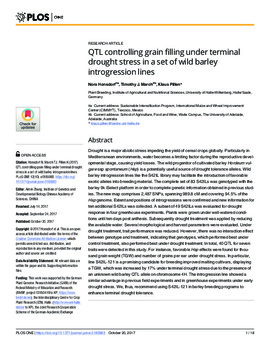Mostrar el registro sencillo del ítem
QTL controlling grain filling under terminal drought stress in a set of wild barley introgression lines
| Creador: | Honsdorf, N. |
| Creador: | March, T.J. |
| Creador: | Pillen, K. |
| Año: | 2017 |
| URI: | https://hdl.handle.net/10883/21075 |
| Lenguaje: | English |
| Editor: | Public Library of Science |
| Copyright: | CIMMYT manages Intellectual Assets as International Public Goods. The user is free to download, print, store and share this work. In case you want to translate or create any other derivative work and share or distribute such translation/derivative work, please contact CIMMYT-Knowledge-Center@cgiar.org indicating the work you want to use and the kind of use you intend; CIMMYT will contact you with the suitable license for that purpose |
| Tipo: | Article |
| Lugar de publicación: | San Francisco, CA (USA) |
| Número: | 10 |
| Volumen: | 12 |
| DOI: | 10.1371/journal.pone.0185983 |
| Descripción: | Drought is a major abiotic stress impeding the yield of cereal crops globally. Particularly in Mediterranean environments, water becomes a limiting factor during the reproductive developmental stage, causing yield losses. The wild progenitor of cultivated barley Hordeum vulgare ssp spontaneum (Hsp) is a potentially useful source of drought tolerance alleles. Wild barley introgression lines like the S42IL library may facilitate the introduction of favorable exotic alleles into breeding material. The complete set of 83 S42ILs was genotyped with the barley 9k iSelect platform in order to complete genetic information obtained in previous studies. The new map comprises 2,487 SNPs, spanning 989.8 cM and covering 94.5% of the Hsp genome. Extent and positions of introgressions were confirmed and new information for ten additional S42ILs was collected. A subset of 49 S42ILs was evaluated for drought response in four greenhouse experiments. Plants were grown under well-watered conditions until ten days post anthesis. Subsequently drought treatment was applied by reducing the available water. Several morphological and harvest parameters were evaluated. Under drought treatment, trait performance was reduced. However, there was no interaction effect between genotype and treatment, indicating that genotypes, which performed best under control treatment, also performed best under drought treatment. In total, 40 QTL for seven traits were detected in this study. For instance, favorable Hsp effects were found for thousand grain weight (TGW) and number of grains per ear under drought stress. In particular, line S42IL-121 is a promising candidate for breeding improved malting cultivars, displaying a TGW, which was increased by 17% under terminal drought stress due to the presence of an unknown wild barley QTL allele on chromosome 4H. The introgression line showed a similar advantage in previous field experiments and in greenhouse experiments under early drought stress. We, thus, recommend using S42IL-121 in barley breeding programs to enhance terminal drought tolerance. |
| Agrovoc: | BARLEY |
| Agrovoc: | INTROGRESSION |
| Agrovoc: | SINGLE NUCLEOTIDE POLYMORPHISM |
| Agrovoc: | DROUGHT |
| Agrovoc: | CEREAL CROPS |
| Agrovoc: | GENOMICS |
| Agrovoc: | GENOTYPES |
| ISSN: | 1932-6203 |
| Revista: | PLoS ONE |
| Número de artículo: | e0185983 |
Ficheros en el ítem
Este ítem aparece en la(s) siguiente(s) colección(ones)
-
Sustainable Intensification
Sustainable intensification agriculture including topics on cropping systems, agronomy, soil, mechanization, precision agriculture, etc.

